The
Dreamscapes of Edward D. Wood Jr.
by Susan MacDonald
author of
Petticoat Punishment in
James Joyce's Ulysses
"Learn to see the worst films…they are
sometimes sublime."
Ado Kyrou,
Surrealism in the Cinema
For
nearly two decades a forgotten eccentric of the 1950s, Edward D.
Wood Jr. is today enjoying a success that quite escaped him in
life. His technically inept, but oddly fascinating, films are
shown at midnight screenings in off-beat picture theatres around
the world.
This revival is largely
due to his being presented to a new audience by Michael Medved’s
1981 book The Golden Turkey Awards, a volume which
attempted to satirise the Academy awards by presenting
nominations and awards for lack of quality. In a Ben
Hur-like performance, Ed Wood won both the award for the
worst director of all time and the award for the worst film of
all time, which was given to his magnum opus, Plan 9 from
Outer Space.

The Ed Wood menagerie, as
played in Tim Burton's film
Ed
Wood.
From the left: Vampira, Bela Lugosi, Criswell, Kathy Wood
(Ed's wife),
Tor Johnson and Ed.
Ed Wood had his own
troupe of players, a bizarre entourage of friends which included
the flamboyant newspaper and television seer Criswell, blond
cowlick spit-stuck to his forehead, whose dramatic future
predictions were nearly always wrong. ("I predict that in
1980 public executions will be shown on television, sponsored by
your local gas company!")

Criswell presents his
febrile introduction to
Plan
9 from Outer Space,
'based on the
secret testimony of the miserable souls who survived this
terrible
ordeal...my friends, can your heart stand the shocking facts
about
GRAVE ROBBERS
FROM OUTER SPACE?'
Criswell (his full name
was Jerome King Criswell ) lived as a child at the rear of his
father’s mortuary business, and for the rest of his life
preferred sleeping in satin-lined coffins, because he found them
so comfortable (as one Ed Wood acquaintance commented, "Where
does Ed find them?")
Another famous member
was the Gothick spider-woman Vampira (Maila Nurmi), whose
raven-black hair, dark make-up, and bloodless pallor marked her
as the heiress to a tradition going back to the early Victorian
age, through the female vampires in Dracula, the silent film
temptress Theda Bara, Morticia Addams of the New Yorker’s
cartoons, and the villainesses of a thousand forgotten radio and
Saturday matinee serials. Even Natasha, from the Rocky and
Bullwinkle cartoon series, is a parody of this interesting
genre, and bears an especially striking resemblance to Vampira.
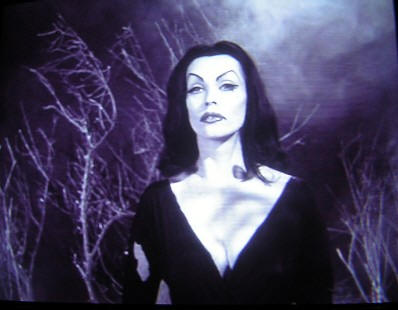
In the early 1950s she
was a late night horror film hostess in Los Angeles, with an
enormous cult following throughout America, and her own
sub-retinue of flunkies and minders. Just before his untimely
death James Dean had been having a love affair with her. With
the popularity of the Goth look in more recent times, Vampira
was forty years ahead of her time.
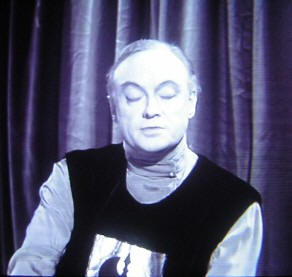
John Breckenridge
("Bunny") was the scion of a wealthy European family, who was
transsexual, and who dreamed of having a ‘Christine Jorgensen’
procedure to change his sex. He was an acquaintance of Ed Wood’s
for several years, but only made one film appearance, as the
alien Ruler in Plan 9 from Outer Space. It is a
performance of such outrageous and hilarious world-weary camp
that one regrets he did not appear in more films.
There were others:
Loretta King, who could not drink any liquids because she was
"allergic to water", the growling Swedish professional wrestler
Tor Johnson, hack actors Paul Marco and Conrad Brooks (the
latter is nicknamed by enthusiasts "the John Geilgud of bad
movies"), and Bela Lugosi, who had starred in Dracula in
1931, but who was now forgotten, depressed, and a narcotics
addict.
Ed Wood gave Bela Lugosi
something to live for again. The two became friends, and Bela
was overjoyed to be making films once more, and with a much more
interesting crew than he had ever known at the major studios.
And
there was another interesting sidelight to Ed Wood’s film
career. He was a very
public cross-dresser. This would be unusual today, but in the
1950s it was unique. There were female impersonators of course,
but Ed was a genuine transvestite. He found women’s clothes and
their soft fabrics sexually enticing, and extremely relaxing. If
there was stress on the film set – and there often is – he would
disappear, and return wearing a wig, a skirt, nylon stockings,
and a fluffy sweater and beret knitted from his favourite
fibre, angora.
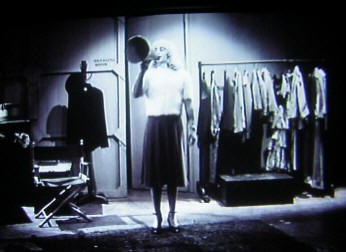 Johnny Depp plays Ed Wood
directing
Johnny Depp plays Ed Wood
directing
Of course the members of
his outlandish menagerie were not put off by this at all. But
Ed had to deal with the wider world too, to raise money for his
pictures. He confronted a great deal of misunderstanding and
prejudice, and one of his films, Glen or Glenda (1953),
is a partly a documentary, explained by a psychiatrist and
overseen by a kind of Science God played by Bela Lugosi, and
partly a fictional story of courtship, whose purpose is to help
people understand and empathise with the phenomenon of
cross-dressing.
Ed Wood even played the
lead role himself, and wanted there to be no doubt in the minds
of the audience that the difficulties the hero encountered
were based on personal experience. It was probably the most
courageous film of the 1950s, and is still the only general-audience film about genuine transvestism from any
English-speaking country. As Ed Wood himself explained, "If you
want to know me, see Glen or Glenda, that’s me, that’s my
story. No question. But Plan 9 from Outer Space is my
pride and joy."
But, for the business
that hired Ed, Glen or Glenda was meant to be a
sensationalist work of mild pornography. When the producer saw
it, he was furious.
Three years later Ed
Wood made the movie which discriminating film scholars regard as
the pinnacle of his career: Plan 9 from Outer Space (shot
in 1956, it was not released until 1959). The film was financed
by the Baptist Church of Beverley Hills. Ed had convinced them
that they should finance a film with the teenage appeal of the
time, and that this film would then generate the money needed to
make twelve films about the apostles of Christ - which were the
movies that the Baptist Church of Beverley Hills really wanted
to make.
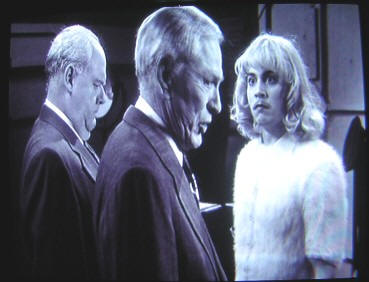
Pastors from the
Baptist Church of Beverley Hills.
'Mr Wood, you cannot direct a film
dressed like that...it is an abomination
in the eyes of
the Lawd!'
The cast included the
best collection of Wood regulars that he ever assembled. The
credits music, which develops into a theme as the film
progresses, was Alexandr Mossolov’s Iron Foundry, a
brilliant choice, full of menace and foreboding. The web site
listed below states, "Iron Foundry enjoys an oddity
reputation, and is rarely heard. Recordings have been few and
far between." Ed Wood was a classical music enthusiast, and any
aficionado of Plan 9 would recognise the music at once.
It might be of interest
to compare the real Ed Wood ‘stock company’ with the modern
actors who portrayed them:
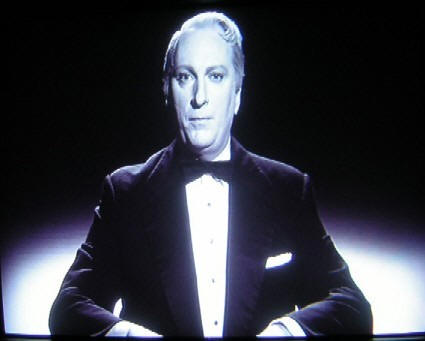
Jeffrey Jones playing
Criswell (compare with the still above)
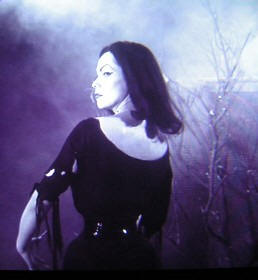
The real Vampira in
Plan 9 from Outer Space

Lisa Marie in the
role. Vampira could not drive, and Ed Wood could not afford
dressing rooms. So to film Plan 9 from Outer Space she
went to the studio by bus, and fully dressed.
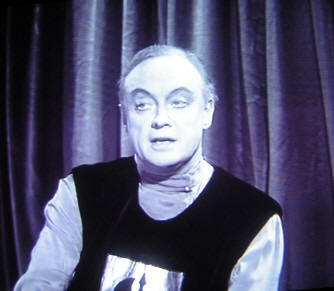
Bunny Breckenridge as
'The Ruler' in Plan 9 from Outer Space
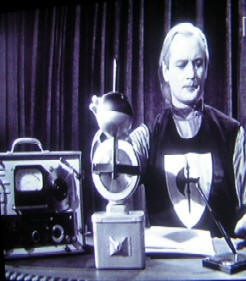
Bill Murray: not
quite as outrageous, but a very good performance
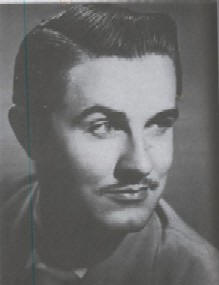
The real Ed Wood
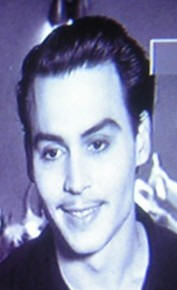
Johnny Depp in the title
role
There have been
documentaries made about Ed Wood’s life and career: Look Back
in Angora, Flying Saucers over Hollywood, and one
biography, Nightmare of Ecstasy. There has even been a
rock video in the Ed Wood manner. But the zenith of the
renewed interest in Ed Wood’s films was the superb biopic
released in 1994, Ed Wood, directed by Tim Burton.
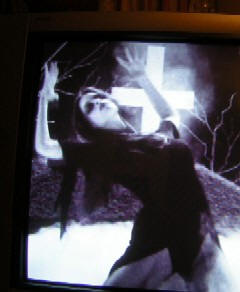
A clip from
the Ed Wood music video
It is an affectionate
homage of notable accuracy, and was probably the best film made
in the 1990s. At the time of writing, it is certainly the last
great film made in gleaming black and white – a decision which
Tim Burton fought hard for, but which was exactly right.
Unfortunately, the use
of black and white harmed the film at the box office. It made
little money, because these days young filmgoers especially do
not understand that black and white cinema has its own special
beauty. But film critics and film magazines gave it the
highest praise. It is a bitter-sweet fact that, even accounting
for inflation, any fifteen minutes of Tim Burton’s film cost
more to make than all the films that Ed Wood made over a period
of 25 years.
The casting of the film
is exemplary. Lisa Marie is amazingly good as Vampira, and
Jeffrey Jones is wonderful as Criswell. He brings a skein of
warm comedy to the role which the real Criswell lacked. Johnny
Depp in the title role projects Wood’s infectious enthusiasm and
joi-de-vivre, and Bill Murray has fun as Bunny
Breckenridge, although no mere actor could adequately
display the real Bunny’s jaded, droll, contrived ennui.
Martin Landau, such a
wooden actor in so many films, won a well-deserved Oscar for his
brilliant portrayal of Bela Lugosi in his final years.
Edward
D. Wood was unique. Is there any explanation for his strange
life? Tim Burton, the director of the 1994 film, concluded that
Ed had wanted to be a film producer and director ever since he
was given a movie camera as a boy, and was bewitched from that
moment on. When he was 17 years old, probably the most
impressionable age in a person’s life, he saw Citizen
Kane, when it was first released. (Ed
was born October 10 1924.)
The youthful Ed Wood
wanted to make films. But his idea of a film director was a
cartoon idea. In cartoons the director habitually wears jodphurs
and shiny black boots, and carries a horsewhip. He sits in a
simple canvas-backed chair, and shouts directions from an
old-fashioned megaphone. He is frequently portrayed with a
pencil-thin moustache, and sporting a beret.
While making his films
Ed always used the megaphone, even though directors at the major
studios had long abandoned its use. He never went for the
jodhpurs or boots, or the horsewhip, but such affectations
predated his memory: they had vanished at the end of the silent
era (the earliest directors dressed this way as a protection
against snakes and scorpions – in the silent days, films were
usually shot on outdoor locations, and often in the desert).
Tim Burton believes that
this is the key to understanding Ed Wood’s style. Ed was in
love with the idea of directing films…the romance, the
persona of the admired but unpredictable martinet, and the
artistic adventure. He enjoyed sitting in the canvas-backed
chair, and shouting "Cut!" He wanted nothing to do with the
tedious side of film directing: the careful attention to
continuity (in his own films characters can drive away from a
house in broad daylight and, after a trip of a mile or so,
arrive in pitch-black, foggy night), the re-shooting of scenes
in which bits of set protruded, or even fell over, the
repetitive rehearsal of important scenes with the actors. In Ed’s
films it was one take, or two at the most. He couldn’t wait to
get on to the next scene, and play director again.
The
best answer to those who have nothing to offer the Ed Wood
renaissance except derisive laughter, is the films themselves.
Ed did try to get a job with the major studios, but none of them
were interested. Anybody else would have gone home and taken a
clerical job. But Ed went ahead and made his own films . . .
shoestring budgets, fantastically strange actors, and
technically inept . . . but they
were made, and released.
And that was much harder
to achieve fifty years ago than it is today, when the major
studios have lost their iron grip on Hollywood, amazing sets and
technical effects are just a software package away, and just
about everybody in cinema boastfully announces themselves as an
"independent".
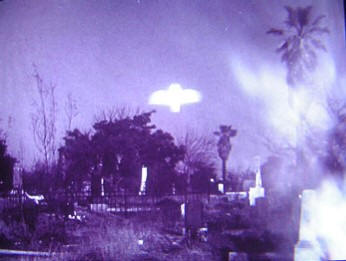
A dream landscape
of dark, surreal mysteries and obsessions
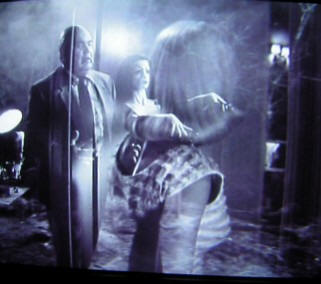
One can glimpse behind those films a special mind of dark,
surreal mysteries and obsessions. After all, there were other
ultra-cheap directors in the 1950s and 1960s, but their films
are about as interesting as the people next door’s home movies.
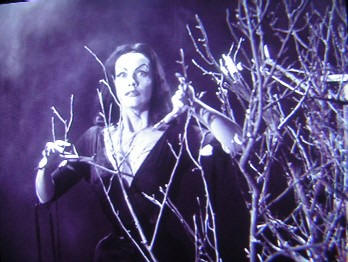 Maila Nurmi
(Vampira) in Plan 9 from Outer Space, and as she is
today
Maila Nurmi
(Vampira) in Plan 9 from Outer Space, and as she is
today
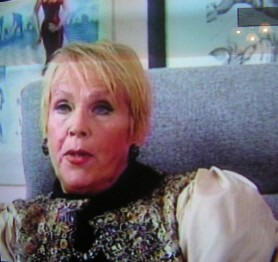
In death Ed Wood found
the intellectual acclaim which had so painfully eluded him while
he was alive and working. All of the chief members of his
repertory are now dead, with the exception of Vampira. Maila
Nurmi used to run a business preparing signed gravestone
rubbings of Hollywood stars, but today she has time for little
else except attending Ed Wood film festivals and special
screenings. She speaks with heartfelt admiration of Ed’s
kindness, and his brightening the last years of Bela Lugosi’s
life, when the rest of Hollywood had turned their backs on him.
Ed Wood died on December
10 1978.
He was not only kind; he was one of a kind.
"The imperfect is alive."
Carl Theodore
Dreyer, Danish film director
List of
Main Films
Glen or Glenda
1953
Jailbait 1954
Bride of the Monster
1955 Bela Lugosi’s last film.
Plan 9 from Outer
Space 1956
Final Curtain
1957
Night of the Ghouls
1958 This film was lost until 1983, because Ed Wood never had
the money together to pay the film developer’s bill. Finally
recovered and released when the Ed Wood renaissance was well
under way, it was immediately acclaimed an ‘Ed Wood
masterpiece.’
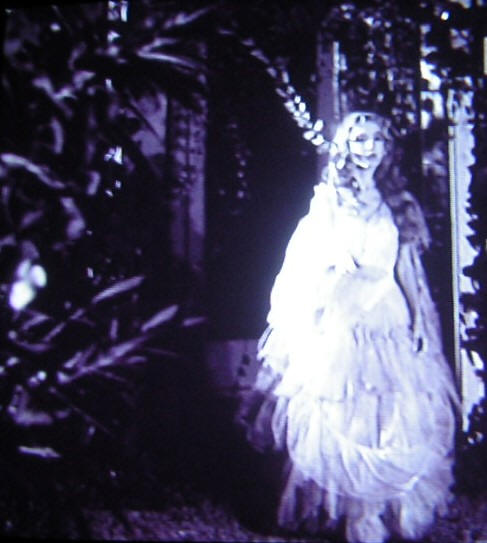 Valda Hansen, one
of the most beautiful of Ed Wood's troupe,
Valda Hansen, one
of the most beautiful of Ed Wood's troupe,
in the
long-unseen Night of the Ghouls
The
Sinister Urge
1960
Orgy of the Dead
1965
Take it out in Trade
1970
Web Sites
There are innumerable
web sites dealing with Ed Wood and his films. Other sites of
interest are:
Bela Lugosi
Vampira
Criswell
Tor Johnson & Plan 9
from Outer Space
Alexandr Mossolov’s
‘Iron Foundry’ – the Plan 9 from Outer Space theme
FLYING
SAUCERS OVER HOLLYWOOD!
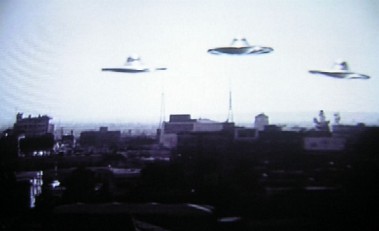
"Visions are worth
fighting for. Why
spend your life living someone else's dream?"
from the film
Ed Wood


















